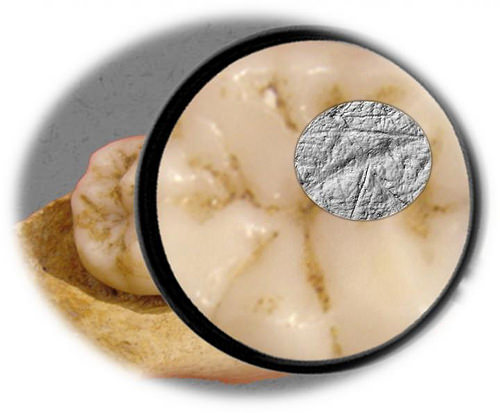
PLOS ONE—When fluctuating climates in the Ice Age altered habitats, modern humans may have adapted their diets in a different way than Neandertals, according to a study published April 27, 2016 in the open-access journal PLOS ONE by Sireen El Zaatari of the University of Tübingen, Germany, and colleagues.
The Neandertal lineage survived for hundreds of thousands of years despite the severe temperature fluctuations of the Ice Age. The reasons for their decline around 40 thousand years ago remain unclear. The authors of this study investigated the possible influence of dietary strategies using the fossilized molars of 52 Neandertals and Upper Paleolithic Homo sapiens (modern humans). They analysed the type and degree of microwear on the teeth to attempt to draw conclusions about diet type and to establish a relationship with prevalent climactic conditions.
________________________________________
This is an image of a fossilized human molar used in the study of dietary habits of Neandertals and Upper Paleolithic Homo sapiens. Credit: Sireen El Zaatari
________________________________________________________
They found that as the climate fluctuated and habitats altered, Neandertals may have adapted their diet to the resources that were most readily available, eating mainly meat when in open, cold steppe environments, and supplementing their diet with more plants, seeds, and nuts when in forested landscapes. Meanwhile, modern humans seemed to stick to their dietary strategy regardless of slight environmental changes and retained a relatively large proportion of plant-based foods in their diet. “To be able to do this, they may have developed tools to extract dietary resources from their environment”” says Sireen El Zaatari. The researchers concluded that Upper Paleolithic modern humans’ differing dietary strategies may have given them an advantage over the Neandertals.
The Neandertals may have maintained their opportunistic approach of eating whatever was available in their changing habitats over hundreds of thousands of years. However, modern humans seem to have invested more effort in accessing food resources and significantly changed their dietary strategies over a much shorter period of time, in conjunction with their development of tools, which may have given them an advantage over Neanderthals.
The European Neandertal and modern human individuals analysed in this study do not temporally overlap and thus would not inform us about direct dietary competition between these two groups. Nevertheless, if the behavioral differences detected in this study were already established at the time of contact between them, these differences might have contributed to the demise of the Neandertals and the survival of modern humans.
Source: PLOS ONE press release.
___________________________________________________
*El Zaatari S, Grine FE, Ungar PS, Hublin J-J (2016) Neandertal versus Modern Human Dietary Responses to Climatic Fluctuations. PLoS ONE 11(4): e0153277. doi:10.1371/journal.pone.0153277
___________________________________________________

______________________________________________
Travel and learn with Far Horizons.
____________________________________________
This richly illustrated issue includes the following stories: Recent findings shedding new light on the whereabouts of the remains of Philip of Macedon, father of Alexander the Great; how an archaeologist-sculptor is bringing bones of the dead back to life; archaeologists uncovering town life at the dawn of civilization; an exclusive interview with internationally acclaimed archaeologist James M. Adovasio about what makes the Meadowcroft Rockshelter prominent in the ongoing search for the first Americans; what archaeologists are finding at the site of the ancient city of Gath, the home town of the biblical Philistine giant, Goliath; and how scientists are redrawing the picture of human evolution in Europe. Find it on Amazon.com.









